|
~Skeg's Guide to Building Coasters~
by Skeg
The
Basics
Know
Your Coaster
Coaster
Design
Your
First Coaster
Keeping
The Intensity Low
Keeping
The Excitement High
Special
Track Elements and Knots
Underground
Coasters
Racing
Coasters
The
Rollerbus
Coasters
For Scenarios
|
The Basics
So just how do you build the ultimate coaster?
Firstly, it depends on what you're trying to do. Trying to complete one of
the scenarios with limited money and space is different from building your
dream ride in your own park with lots of space and spare cash. Building
coasters in scenarios is covered later.
However, all coaster designs aim for the following:
Keep the intensity low.
Keep
the excitement high.
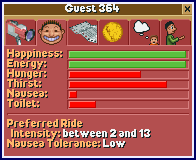 The first is the most important. Whilst
your peeps will ride a coaster of intensity of more than ten, they will
usually only do so if they've been on other rides. Additionally, the
higher the intensity, the lower the excitement. A high intensity also
means a high nausea rating. Whilst this may not be a problem if you have
Handyman #32 patrolling the area, pukey people don't go on rides (so you
don't get their cash) and they aren't as happy as they could be. If you
keep the intensity low, you don't need to worry too much about pavement
pizzas.
The first is the most important. Whilst
your peeps will ride a coaster of intensity of more than ten, they will
usually only do so if they've been on other rides. Additionally, the
higher the intensity, the lower the excitement. A high intensity also
means a high nausea rating. Whilst this may not be a problem if you have
Handyman #32 patrolling the area, pukey people don't go on rides (so you
don't get their cash) and they aren't as happy as they could be. If you
keep the intensity low, you don't need to worry too much about pavement
pizzas.
Once you've got to grips with designing a low intensity (i.e. less than
ten) ride, you need to concentrate on problem number two; exciting rides.
The more exciting the ride, the more people will go on it (and eventually
turn into Captain Chunder - but hey, at least they enjoyed themselves and
spent money). Even more importantly, the higher the excitement, the more
your peeps will pay for the privilege of being scared s**tless. I know,
I've been there.
If you're playing one of the scenarios and space/time/money is tight or
building your own park and just trying to fit an extra coaster in, then
you only need to worry about intensity. Your peeps will ride it regardless
of the excitement, as long as the price is right. However, if you want to
design the ultimate thrill ride (and/or make more money) then you need to
look at the excitement factor.
Back to the Top
|
Know your coaster
First of all you
need to know your coaster! You've probably got this figured already but...
Most important of all is to test your rides before you open them. Click on
the yellow traffic light in the ride window. That way you can make sure
that your coaster won't crash and by clicking on the 'test' tab you can
check out your ride stats.
Look at the pre-built coasters that come with the game. Build one of
them and follow the train round (in the coaster window click on 'overall
view' and change it to train 1 or 2 or whatever). Different rides have
different tolerances and by watching the train go round you can get a good
idea of what sort of things that type of coaster can do and how you can
design your own basic scream machine.
 Next, check out the graph tab. By clicking on the
various options, you can see the altitude, velocity and various g-forces
that the ride offers. We'll come back to this later. You can also find out
what people think of your coaster by clicking on the tab with the peeps on
it. That way you'll be able to find out if it's priced too high or is too
intense. Don't worry if they complain that they won't ride 'Shiny Coaster
by Me' in the rain. Unless your ride is new or you get repeat rides they
won't. But make sure you've got plenty of rides that they will go on (see
the mega park guide). The same applies if your peeps
think that "'Shiny Coaster By Me' looks too intense to me'. Their
intensity tolerance will increase after they've ridden a few gentler
rides.
Next, check out the graph tab. By clicking on the
various options, you can see the altitude, velocity and various g-forces
that the ride offers. We'll come back to this later. You can also find out
what people think of your coaster by clicking on the tab with the peeps on
it. That way you'll be able to find out if it's priced too high or is too
intense. Don't worry if they complain that they won't ride 'Shiny Coaster
by Me' in the rain. Unless your ride is new or you get repeat rides they
won't. But make sure you've got plenty of rides that they will go on (see
the mega park guide). The same applies if your peeps
think that "'Shiny Coaster By Me' looks too intense to me'. Their
intensity tolerance will increase after they've ridden a few gentler
rides.
One more important thing to keep an eye on is the queue time. If people
are queuing too long for your ride, they're not getting any happier (and
you're not getting their cash). Shorten the queue or change the ride
timing so that people aren't hanging around. Try to build the ride
entrance near the front of the ride so that your peeps can just jump
straight on instead of spending time walking down the platform. Don't
worry about the exit too much (but see mega park guide for some cunning strategies).
If your coaster seems to be breaking down too much you can change the
'inspection rate' under the cogs tab. See *)disasters for details and how to cope with the "not
*that* many people have died in an accident on 'Shiny Coaster By Me' but
my park rating has plummeted" problem.
*)A Note from Maurine: disasters: Sorry, somehow the Tutorial for the Scenarios got lost.
But I will try to find it somewhere, if possible.
Back to the Top
|
Coaster design
So, how do you
build a great coaster? That depends on what you want. Either you want to
build in an existing park or scenario where money and space are tight or
you have a blank map and all the money in the world. Either way, you need
to practice! With unlimited money and time you get to know how the game
works. The more rides you build, the better you'll be. The better you get,
the easier it becomes. We'll start with the basics:
Back to the Top
|
Your first coaster
I'm assuming
you've played a few scenarios and watched the tutorial so you know about
building lift hills and curves etc. and have checked out the pre-built
coasters in the game. Once you've done that download a blank map and play
around until you've got to grips with the interface. Just build a few
different types of coaster (you don't need to open the park or rides)
until you're familiar with each coaster type. That way you'll discover the
fundamentals such as:
Tracks need a clearance of 2 over
other tracks and paths (3 for suspended coasters or over certain
types of track such as inline twists and water splashes).
When building underground, the track
must enter a vertical cliff face of height at least 2 (or 3 for
suspended).
Each track element must be either
entirely above or below ground - you can't have a helix
half-sticking out of a cliff face.
Often the corners of land squares
adjacent to track elements must be the right height too.
You need to allow for an exit and an
entrance and their paths. I've often built the world's best coaster,
only to discover that there's no room to get people on and off the
ride. Build your entrances and exists first if you're designing a
compact ride.
Gravity!
Play about a bit
and test the rides that you've built. They'll probably be completely
unrideable, but you're not going to open them so it doesn't matter. Which
brings us nicely on to the next point:
Back to the Top
|
Keeping the intensity low or how to build a good
coaster
The temptation is to build a terrifyingly
fast ride with loops followed by corkscrews followed by twists, all taken
at 100mph. Don't! It may be exactly the sort of coaster that you or I
would like to go on, but your peeps are wusses and will take one look at
your ride and go on 'Ferris Wheel 1' instead. Think 'would my granny go on
the ride?' If she wouldn't, neither will Guest#345. Try to keep the
intensity below 10. Here's how:
Slow down!
Trains can go up as well as down hills. A coaster
going too fast causes the most problems. Put a hill in before a loop or
change a curve into an upward helix. If you really have to you can put a
brake in, but that's no fun for the riders and is bad design.
Always use banked curves.
The main exception to this is at
the start of a ride when the train is coming out of the station or just
coming into a station (you did use up all the train's speed on the ride or
put brakes before the station to avoided crashes didn't you?)
The faster the speed, the larger radius of curve you should
use.
Even better use a cobra
roll.
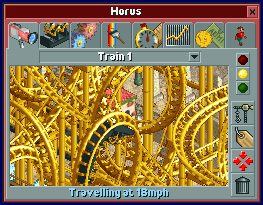 Don't go through loops and corkscrews too
quickly.
Don't go through loops and corkscrews too
quickly.
Try to hit small vertical loops and corkscrews at
about 35mph. You can get away with 50mph, but not very often. In-line
twists and half loops can be taken at about 50mph, but the slower the
better. The large loop on the steel twister needs to be entered at about
50mph too. Of course the speed will vary depending on the length of train
you are using and the layout of the track just before and after each
inversion. Watch the train go round the loop. It shouldn't be going more
than 20mph at the top.
Don't change direction too quickly.
Don't hurtle through a
curve at 80mph and then throw the riders round a bend in the opposite
direction. They will definitely throw up!
Reduce the number of cars on each train.
This decreases the
momentum of the train so it will go a bit slower. Be warned though, as it
may mean that your coaster won't get through all those carefully designed
loops!
Build your coaster a section at a time.
Put in a few bends or
loops and then send the track right back to the station. Test your ride
and look at the stats. If the intensity has shot up from 6 to 16 then
you'll have a fairly good idea where the problem is. Follow the train
round and watch the speed. You should be able to pinpoint the problem
straight away. If not look at the graph tab in the coaster box. Check for
rapid changes in lateral g's or long periods of positive g's. That means
that your riders are been thrown about too much or being pushed into their
seats for too long and they won't like it. Negative g's - 'airtime' is
generally a good thing so unless they're off the scale or there's a lot of
quick changes between positive and negative g's you don't need to worry
about them. Once you've spotted the problem you can redesign your ride -
you'll only need to do the last couple of sections because you're building
bit by bit! Building slowly also allows you to spot problems before they
happen. It's no fun if you've just built the world's most exciting ride
only to discover that your train won't go round a loop or up a hill.
Practice!
The more coasters you build, the better you'll get.
It's not as if it's a terrible chore is it? You'll soon be building rides
with 10 inversions and 80-foot drops, all with an intensity of 8. Once you
get the feel of each type of coaster you can build longer and longer
sections of track before you test. Eventually you'll be building rideable
coasters in about 10 minutes and only testing them before you open them.
Trust me!
Back to the Top
|
Keeping the excitement high or how to build a great
coaster
So now you know how to get people on your
rides, but how do you get them to part with stupid amounts of money? This
is where the excitement factor comes in. Rule number one is keep the
intensity below 10!. Whilst your peeps will eventually go on extremely
intense rides, once the intensity goes above 10, the excitement rating
drops. The best way to build an exciting coaster is to use your
imagination. The game uses certain criteria to assess the excitement
rating of a ride, but what would thrill you? Chances are, that's what
would make the ride more exciting. Here are a few ideas:
Cross the track.
Making your coaster dive in and out of the
structure will make the ride more thrilling for your peeps, especially if
the track passes just underneath another section. It also gives them a
chance to see other parts of the ride. Design a section of track to go
through a loop, or better still, have a 'loop through a loop' . Generally
there needs to be about 4 levels of difference between the two loops. It's
also advisable to have a few other things happen between the loops. That
way not only do you avoid extreme differences in drop and sharp curves, it
also gives your peeps something to think about! If the double loop is the
main feature of your ride, you can experiment with the ride timings to
ensure that you have a train going through each loop at the same time. You
can also design knots (see below)
into your coaster to give it the feel that it is racing itself. This can
be as simple as a couple of helices or as complicated as your warped mind
will allow.
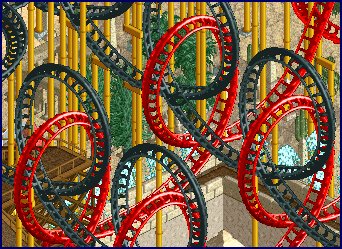 Cross the track with other rides and
paths.
Cross the track with other rides and
paths.
Have the track dive underneath a queue or loop through
another coaster. I often design rides with loops near the station so that
I can build the queue line through the loop. Build a loop that goes
through another coaster's loop (tricky!)
Use the land.
Build some (or all - see below)
of your coaster underground - essential for a mine train coaster
(otherwise you may as well just build a wooden twister!). Make the train
dive off a cliff or swerve to miss a rock face. Try to use the land,
rather than build against it. It's cheaper but it looks better too. If you
do have to raise or lower land, try to lower it - there's nothing worse
than seeing big chunks of land sticking up everywhere.
Use scenery and themeing.
Careful use of trees will hide the
rest of the track from your peeps. Themeing adds a lot to a ride's
excitement value. Don't overdo it though - and try to be consistent.
Building a mineshaft next to a pyramid won't affect the excitement factor
but it will look a bit stupid. Not that you can't mix themes; a few
dinosaur bones in an Egyptian desert or some mine barrels in a Roman Villa
will look good. Don't forget that you can alter the type of the terrain
too. Again, it won't alter your coaster's stats, but used consistently it
will make your ride look great.
Keep the speed up. I know I've said that you should take it
slowly, but the faster the ride, the more exciting it is. Just be sure
that it won't make your coaster too intense.
Plan ahead.
What do you want your ride to do? Where do you
want it to go? I often build the main feature of the ride first and then
work backwards and forwards from that. Where do you want the station to
be? You might have designed the world's most intertwining coaster, but if
you then need a long, boring straight section of track to get the train
back to the station then it's not the world's most exciting ride is it?
Build the ride 'feature by feature'.
Think of it as designing
lots of smaller coasters in a row. So you want an interlocking loop or a
large knot? Well build that part of the ride and then test. Not only do
you ensure that you keep the intensity down, it also allows you to plan
ahead by looking at the speed of the train after each 'mini coaster'. It's
also the only way to build a
single racing coaster
that works. Once you've completed each feature section
you can leave it alone, knowing that your 'must have' set of helices that
you're going to build a roto-drop in later can remain intact. Whilst you'd
like to have each 'mini coaster' intertwining with previous ones, it's not
a disaster if they don't - each of your 'coasterettes' is a ride in
itself. You can even have different sections underground or separated by
mountains, with each feature surrounded by different themeing.
Improvise!
Of course, nothing ever works quite how you
planned it! Think of it as an opportunity to improve your ride. What if
the train comes bombing out of your last set of features at 60mph - a bit
fast for the triple corkscrew you had planned? Well you could have the
train go up a hill before the corkscrews, but even better, you could use
the train's speed to send it into a large loop. Train going too fast for
the 90-degree turn you need? Use a
half
cobra instead.
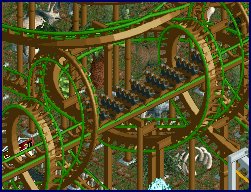 Make it look good. Make it look good.
Usually, if a ride looks
good it will be exciting too. A path going through the middle of a loop, a
suspended coaster that has people's feet skimming a rock face, a mine
train bombing into a hole or a big woodie that dives in and out of its
supports not only makes the ride more exciting, but it looks great. Try
and have the boring bits of your coaster go underground or through other
rides. If you can't avoid a long, straight section of track, have a couple
of other coasters loop round it or send it underground. If that's not
possible, surround it with trees and theming. All will make the ride more
exciting.
Back to the Top
|
Special track elements and
knots
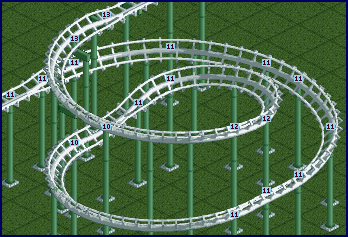 By now you'll be pretty familiar with all the special
track elements for each ride, but don't forget you can join them up! In
this way you can find even more exciting ways to go round bends and change
direction. Often they're less intense than simply having your track go
round a corner too. It can be as simple as using an inclined curve on a
steel mini instead of going straight up or down a hill and then round a
bend, or as complicated as a knot of curves and helices instead of a two
level drop. Make it up as you go along! Here's a few of the main ones that
I use and which can be found on real coasters all over the world.
By now you'll be pretty familiar with all the special
track elements for each ride, but don't forget you can join them up! In
this way you can find even more exciting ways to go round bends and change
direction. Often they're less intense than simply having your track go
round a corner too. It can be as simple as using an inclined curve on a
steel mini instead of going straight up or down a hill and then round a
bend, or as complicated as a knot of curves and helices instead of a two
level drop. Make it up as you go along! Here's a few of the main ones that
I use and which can be found on real coasters all over the world.
Corkscrew U-turn.
Build two half corkscrews in the same
direction to perform the coaster equivalent of a handbrake turn. It's
quite intense. Even better is: 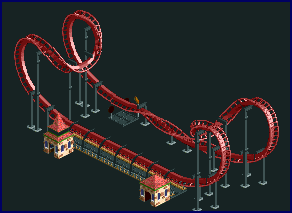
Cobra roll.
A half loop followed by two half corkscrews in
the same direction, followed by another half loop. Combine two of them to
make a simple ride.
Half cobra roll.
To turn through 90 degrees build a half loop
followed by a half corkscrew.
Half boomerang.
Basically a half cobra roll but build a half
corkscrew followed by a half loop. 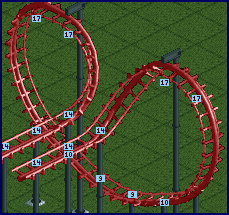
Boomerang.
A sort of inverted cobra roll. Half corkscrew,
half loop, track up, half loop, half corkscrew. 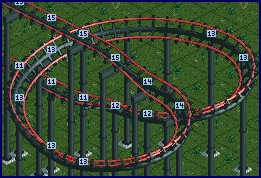
Heart loop.
Track ends up 4 levels below where it started,
but going the other way! Track down, small helix down, two banked wide
turns, banked medium turn, small helix down, track down.
There are lots of others, but these are the main ones that I use,
although I often add in extra bits (such as an inline twist half way
through a cobra roll). The flying coaster is a good coaster to use of this
since you can build the track 'upside down' too.
Back to the Top
|
Underground coasters
To
build a coaster completely underground, first lower a section of land to
the required level (you may have to lower more than one section so that
you can see what you're doing!). Next, place a section of track on the
lowered land. Build the next section of track underground. This will be
your starting point. Now go back to your original track, delete it and
raise the land. Simple! This technique can also be used for building rides
that start in 'mid air'. Just raise the land, build a section and lower
the land again. Don't build too high though, or you won't be able to get a
path up to it. A path's maximum height above ground is 20.
Back to the Top
|
Racing coasters
Racing or dueling
coasters are basically coasters which leave the station simultaneously
(check the 'synchronize with adjacent station' box under the cogs tab of
the coaster window). They run parallel to each other for most or all of
the ride and arrive back at the station at about the same time. There are
two types of racing coaster.
Firstly there's a simple dueling coaster, which is basically two (or
more) separate coasters built side by side. Secondly there's the single
racing coaster, where trains leave one station and arrive at another and
so on until they arrive back in the first station.
A true racing coaster will run parallel to the other section of the
track all of the time, but it is common (and easier to build) a dueling
coaster which goes and 'does it's own thing' sometimes.
Don't forget that for a dueling coaster to run efficiently you'll need
to make sure that trains are leaving all of the stations regularly. It's
no good having a long queue of people waiting at station 1 because the
train in station 1 can't leave because it's waiting for the train in
station 2. Make sure that all stations have a maximum wait time for their
trains, or better still ensure that people want to ride from all stations.
A good way of doing this is to have the end of the queues form a
crossroads on either side of a path. You also need to make sure that you
have the same length and number of trains for each coaster/station.
The easiest racers to build are ones that are mirror images of one
another. Just make sure that each separate coaster stays on one side of
the 'mirror' and then either build an exact mirror image of it on the
other side or use the TD4 mirror utility here to do it for you. This
method works best with smaller coasters such as the wild mouse rides or
the single rail coaster.
The next easiest dueling coasters to build are separate coasters that
don't cross track. They simply run parallel to each other for most of the
way round. If coaster A goes round a tight bend, coaster B follows a
slightly wider turn. The only problem here is that you need to even out
the turns to ensure that the coasters are actually racing. You can of
course always have the rides go and 'do their own thing' for a while to
correct the timing. Any or the woodies look great when this method is
used, but it also works well with the smaller steel coasters.
The hardest racers to design are the coasters that cross each other and
occasionally loop through each other. It's difficult to keep them 'racing'
when they are together. The only tips I have for this is to use a lot of
trial and error and if you get really stuck separate them for a while and
let them wander off until you can get the timing right. I usually build a
big section of racing track for the coasters (with maybe a few simple
crossings) and then design the rest of the first coaster and try to fit
the second in around it. Once I've got them synchronized again I go and
build another racing section. You could build two separate coasters, but I
think that if you're making the effort to cross the tracks you may as well
build one coaster with two stations - the single racing coaster. It takes
longer to test (because you've got to wait for the first train to complete
a circuit before they can start racing), but the 'wow' factor you get when
it works is great!
 A note on single racing coasters: Building
two separate coasters and joining the track will not work! It will just
cause a crash. (Though of course this could be the aim...) Build a simple
loop to get your two stations first and then you can treat each station as
a separate coaster - just remember that track from station A must finish
at station B. Don't forget that you still need to synchronize the stations
and have an even number of trains (this is one of the disadvantages of the
single racing coaster - having to cut back on the number of cars means
long lines!)
A note on single racing coasters: Building
two separate coasters and joining the track will not work! It will just
cause a crash. (Though of course this could be the aim...) Build a simple
loop to get your two stations first and then you can treat each station as
a separate coaster - just remember that track from station A must finish
at station B. Don't forget that you still need to synchronize the stations
and have an even number of trains (this is one of the disadvantages of the
single racing coaster - having to cut back on the number of cars means
long lines!)
Back to the Top
|
The Rollerbus
You've built a
huge park or a park with widely spread attractions. You've even been
helpful to your peeps and built them a nice (free!) monorail to get them
from A to B, but guess what? They won't use it. They want to go on
something more thrilling. No problem. Build them a rollerbus. Most
coasters can have more than one station (usually up to four) so why not
built a mine train coaster instead of a miniature railway? Just remember
that you can only use 'continuous circuit mode' and try to made each
section of track between stations the same ride length (in time). You'll
also need to fiddle with the timings and train length (just as you would
on a transport ride) so that there's a fairly continuous flow of traffic.
Of course a lot of peeps will get to point B and just jump straight back
on back to point A, but at least they're happy and spending money.
You can even combine the ideas of the Rollerbus and racing coaster to
create a really exciting transportation system. If you do this, be sure to
use more than one coaster. As I've found out, two sets of two synchronized
stations is too much for the game to handle! You'll also have very long
lines.
Back to the Top
|
Coasters for scenarios
For tips on completing the scenarios click
here.
The scenarios are great fun to play and building coasters in them is a
real challenge. Usually you have limited space, time and money. Just how
do you build 'Ultimate Thrill Ride 67' in a scenario? Simple answer: you
don't. So what do you do (copyright Adam Ant)? Hopefully by now you know
how to build a shiny new coaster. If not, go and practice some more.
Remember that you don't need to build the world's most exciting coaster.
Your scenario coaster might not set the world alight, but as long as it's
not too intense, peeps will ride it. In the scenarios you won't have much
time to experiment and test new bits of track - guest#409 is lost and
wants to go home. You should already know what does and doesn't work.
Try designing a few small, cheap coasters yourself in an empty, flat
park and save the track. Here's a few points to bear in mind:
Keep the price below 10k.
Otherwise you'll spend ages waiting
to save up enough money to build your coaster.
Make it exciting without going underground or using any other
tricks.
Remember that when you build saved designs they just get
plonked on top of whatever bit of terrain is already there. For this
reason you should also:
Keep below the maximum height allowed for each coaster.
In
the scenarios you probably won't be building on flat ground; as a result
some parts of your ride will be higher than normal. If part of your
coaster is too far off the ground you won't be able to build it. The
higher you go the more expensive it is too, so your cheap coaster on the
flat might cost a fortune if the highest part is in the sky when you build
it on the side of a hill.
Keep it compact.
Not only will it be cheaper, but the less
bits you have sticking out, the more likely it will be to fit into the
space available.
Use 'powered launch mode...'
... and 'reverse incline launch
mode'. These are especially useful for building small coasters, as you
don't need to design a complete circuit. You can just have a few loops and
knots.
Once you've got a set of 'scenario coasters' you can use them, together
with the pre-designed coasters from the game to get your scenario off to a
flying start. You can build them instantly to attract more peeps to your
park. More peeps brings you closer to your goal and also brings in more
money to build decent coasters later.
Not all coasters lend themselves being pre-built - the mine train is a
good example as it benefits from going underground (copyright The Jam).
Some coasters, such as the mini steel or single rail ones are better if
they are built from scratch since they are ideal 'fillers' which can be
built to meander through and around other rides.
Eventually you'll want to build a custom coaster anyway. Perhaps the
terrain is difficult, you need to build underground, have limited space,
you're bored, or whatever.
The first thing to do is save the game! - especially if you'll
have to alter the terrain (which costs a lot to do and costs even more to
undo). Things will probably go wrong, so it's useful to be able to start
from scratch if you need to. If you want you can save the game as you're
building - perhaps you want to see if something works or you're about to
spend a lot of money bringing the diggers in. Either way, you might want
to save it under a different name. As you're building, particularly if
it's a big coaster, periodically check on your park. It's easy to get
carried away trying to work out how best to fit coaster A through coaster
B, but you still need to make sure that the puke's being swept away. Often
you'll be sat around waiting for extra cash to build a loop anyway, but
don't sit there idly - have a look around! Don't be afraid to take a break
from building your coaster. If your research department has just designed
a new thrill ride then go and build it... It won't cost much, it'll keep
your peeps happier than a swine in mud and while you're faffing around
with that you'll be earning money to build your new coaster.
Back to the Top
© Skeg. Not to
be reproduced without permission.
|
::: Copyright © 2001-2007, Skeg RCT Fun, All Rights Reserved. :::
|